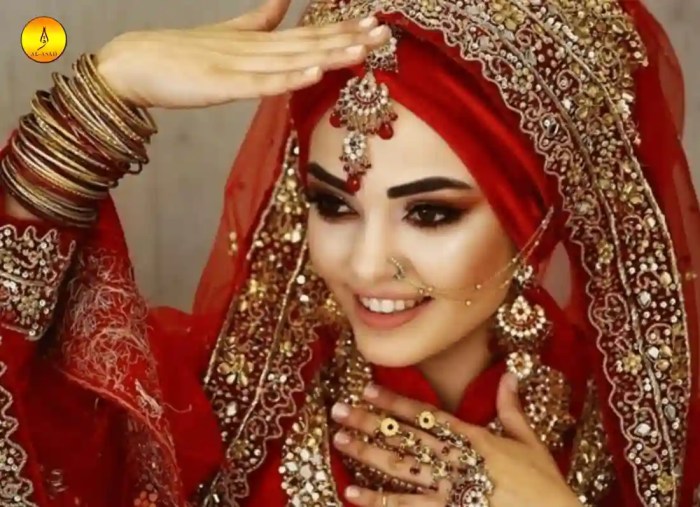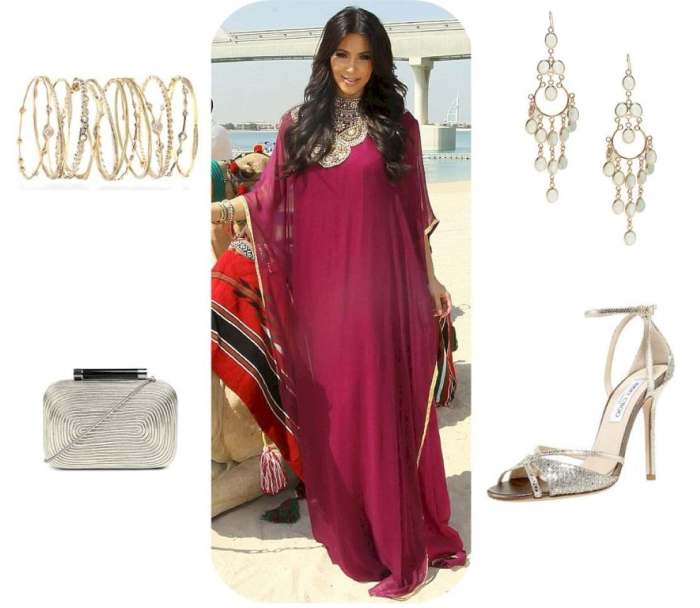Muslim Wedding Guest Dress Code Etiquette
Muslim wedding dresses guest – Attending a Muslim wedding requires understanding and respecting the cultural significance of modesty in dress. This guide provides insights into appropriate attire, popular styles, accessory choices, and resources for finding suitable outfits, ensuring you participate respectfully and elegantly.
Appropriate and Inappropriate Attire for Guests
Modesty is paramount at Muslim weddings. Guests should dress respectfully, avoiding revealing clothing. The level of formality depends on the wedding’s setting and the invitation’s instructions. Generally, loose-fitting, long-sleeved garments are preferred. Avoid anything too tight, short, or transparent.
Cultural Significance of Modesty in Muslim Wedding Attire
Modesty ( haya) is a core Islamic value. At weddings, modest attire reflects respect for the religious context and the celebration’s sanctity. It avoids drawing undue attention to the guests themselves and keeps the focus on the couple and the ceremony.
Examples of Acceptable and Unacceptable Dress Choices
Acceptable choices include long dresses, flowing skirts with tops that cover the shoulders and chest, and elegant jumpsuits with modest sleeves. Unacceptable choices include short dresses, low-cut tops, revealing necklines, tight-fitting clothing, and clothing that is overly revealing or transparent.
| Attire Type | Appropriateness | Cultural Significance | Examples |
|---|---|---|---|
| Long Dress | Appropriate | Reflects respect and modesty | Floor-length gown in a rich jewel tone, maxi dress with long sleeves |
| Jumpsuit | Appropriate (if modest) | Offers a stylish yet respectful option | Wide-legged jumpsuit with long sleeves and a high neckline |
| Short Dress | Inappropriate | Revealing and disrespectful | Mini dress, short skirt and top combination |
| Tight-fitting Clothing | Inappropriate | Draws unwanted attention | Bodycon dress, clingy fabric |
Popular Styles of Guest Attire at Muslim Weddings: Muslim Wedding Dresses Guest
Muslim wedding guest attire varies based on regional traditions and personal preferences. However, modesty remains a consistent theme. This section explores popular styles, encompassing both traditional and Western-inspired modest fashion.
Popular Dress Styles and Regional Variations
Popular styles include long, flowing dresses in various fabrics and colors. Regional variations might incorporate traditional embroidery or embellishments. In some cultures, guests may opt for more elaborate attire, while in others, a simpler, elegant style is preferred.
Comparison of Modest Western and Traditional Muslim Attire
Modest Western styles often adapt Western silhouettes (like A-line or empire waist dresses) to incorporate modest elements such as longer lengths and sleeves. Traditional Muslim attire often features regional specific cuts and embellishments, but always prioritizes modesty.
Examples of Fabrics, Colors, and Embellishments
Common fabrics include silk, chiffon, crepe, and brocade. Popular colors range from rich jewel tones to softer pastels. Embellishments may include delicate embroidery, beading, or lace, but should be tasteful and not overly flashy.
Three Outfit Designs for a Muslim Wedding Guest
- Outfit 1: A floor-length emerald green silk gown with long sleeves and a modest neckline, adorned with subtle beading around the waist. Paired with elegant gold jewelry and a matching clutch.
- Outfit 2: A knee-length A-line dress in a soft blush pink chiffon, featuring delicate lace detailing at the neckline and sleeves. A simple hijab in a coordinating color and pearl earrings complete the look.
- Outfit 3: A navy blue crepe jumpsuit with wide legs and long sleeves, featuring a subtle V-neckline. Accessorized with a statement belt, silver jewelry, and a sophisticated handbag.
Accessories and Styling for Muslim Wedding Guests
Accessories play a crucial role in completing a modest yet stylish look. However, cultural sensitivity is paramount when choosing accessories for a Muslim wedding.
Appropriate Accessories: Jewelry, Head Coverings, and Handbags
Appropriate accessories include modest jewelry (avoiding overly flashy pieces), a hijab (if desired or culturally appropriate), and a sophisticated handbag. The choice of accessories should complement the outfit without overshadowing it.
Cultural Implications of Accessory Choices

Source: quranmualim.com
Certain accessories may hold specific cultural meanings. For example, the choice of hijab color and style can vary significantly based on regional traditions. It’s advisable to research the cultural context to ensure your choices are respectful.
Potential Cultural Faux Pas Related to Accessories

Source: sandiegotowingca.com
Avoid overly flashy or revealing jewelry. Ensure head coverings are appropriate and respectfully worn if choosing to wear one. Overly large or ostentatious handbags might be considered inappropriate.
Dos and Don’ts Regarding Accessories
- Do: Choose modest and elegant jewelry, opt for a hijab if comfortable and culturally appropriate, select a sophisticated handbag.
- Don’t: Wear overly flashy or revealing jewelry, choose a head covering that is disrespectful or inappropriate, carry an overly large or ostentatious handbag.
Finding Appropriate Dresses for a Muslim Wedding
Finding the perfect outfit for a Muslim wedding requires careful consideration and planning. This section provides a step-by-step guide to help you locate suitable attire.
Step-by-Step Guide to Finding a Suitable Dress
- Check the Invitation: Determine the level of formality from the invitation.
- Consider the Venue and Season: Choose fabrics and styles appropriate for the weather and location.
- Browse Online and Offline Retailers: Explore online stores specializing in modest fashion and visit local boutiques.
- Try on Different Styles: Experiment with different silhouettes and fabrics to find what suits you best.
- Accessorize Carefully: Complete the look with appropriate and tasteful accessories.
Online and Offline Resources for Locating Appropriate Attire
Online resources include websites specializing in modest fashion, while offline options include local boutiques, department stores with dedicated modest sections, and specialized bridal shops.
Determining the Level of Formality Based on the Wedding Invitation
The invitation usually indicates the level of formality. Formal weddings may require floor-length gowns, while less formal events might allow for knee-length dresses or elegant jumpsuits.
Adapting Existing Clothing to Be Suitable, Muslim wedding dresses guest
Existing garments can be adapted. A simple top can be paired with a longer skirt or a scarf can be used to add coverage to a neckline or shoulders.
Illustrative Examples of Guest Attire
Here are detailed descriptions of three distinct outfit styles suitable for a Muslim wedding guest, showcasing different approaches to modest yet stylish attire.
Floor-Length Gown in a Rich Jewel Tone
Imagine a floor-length gown in a deep sapphire blue silk, featuring a graceful A-line silhouette and long, elegant sleeves. The neckline is high and modest, perhaps adorned with delicate beading. Paired with silver drop earrings and a matching clutch, this outfit exudes sophistication and elegance.
Knee-Length A-Line Dress in a Pastel Shade
Envision a knee-length A-line dress in a soft lavender chiffon, embellished with delicate lace appliqués at the neckline and sleeves. The dress features a modest round neckline and three-quarter sleeves. A matching hijab in a lighter shade of lavender and pearl stud earrings complete the look, creating a charming and refined ensemble.
Jumpsuit with Long Sleeves and Wide Legs
Picture a jumpsuit in a rich burgundy crepe fabric, featuring long sleeves and wide, flowing legs. The neckline is high and modest, perhaps a simple round neck or a subtle V-neck. A wide statement belt cinches the waist, adding definition. Accessorized with gold hoop earrings and a structured handbag, this outfit offers a stylish and comfortable alternative to a dress.
FAQ Compilation
What if the invitation doesn’t specify a dress code?
When in doubt, err on the side of modesty. A knee-length or floor-length dress in a muted color is generally a safe bet.
Can I wear a jumpsuit to a Muslim wedding?
Yes, a long-sleeved, wide-legged jumpsuit in a respectful fabric and color is perfectly acceptable.
What kind of jewelry is appropriate?
Subtle and elegant jewelry is suitable. Avoid anything too flashy or ostentatious.
Are there specific colors to avoid?
While there aren’t strict rules, it’s generally best to avoid overly revealing or bright colors that might draw undue attention.
Where can I find modest wedding guest dresses?
Many online retailers and boutiques specialize in modest fashion. Check out online marketplaces and local stores.
